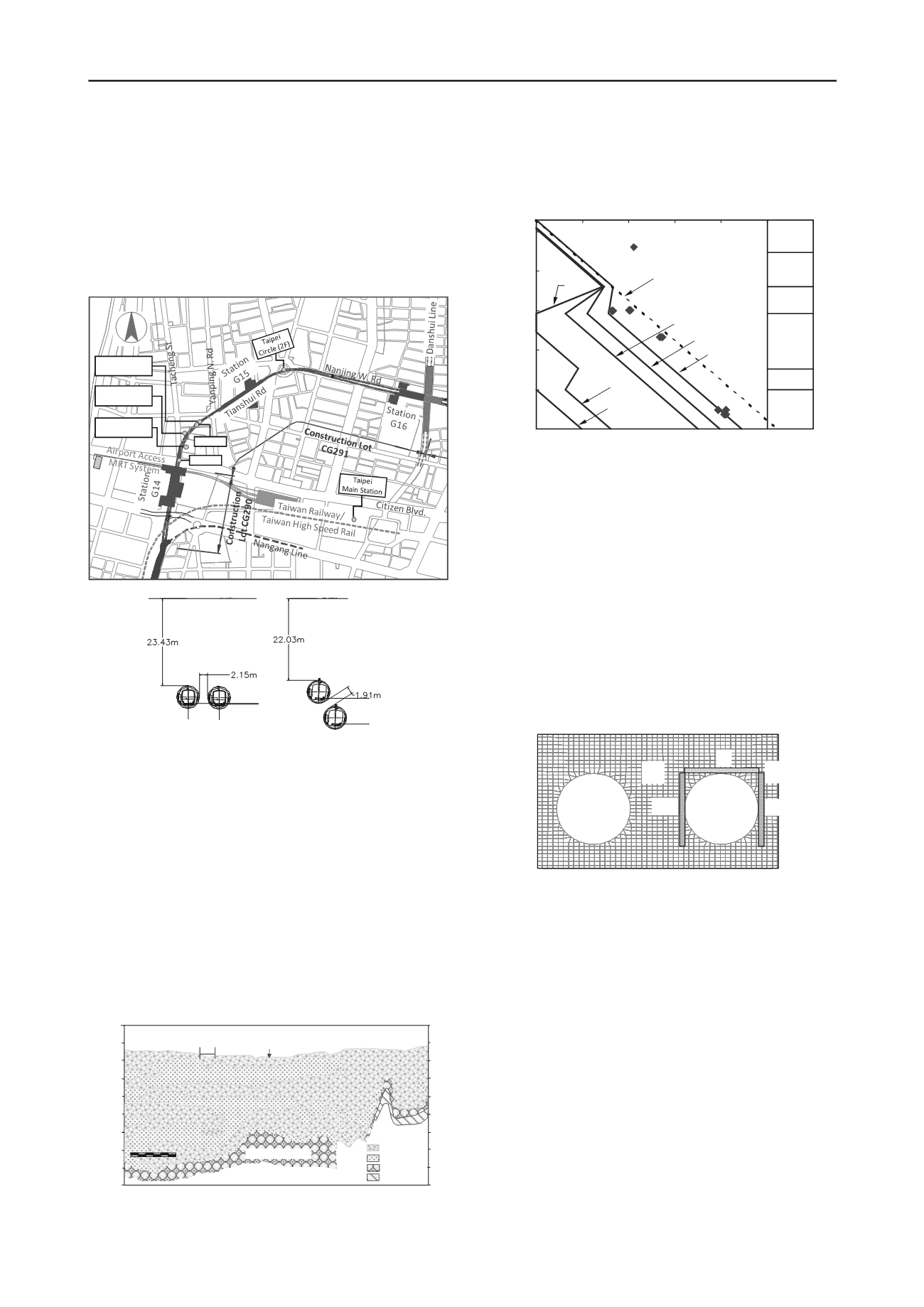
1688
Proceedings of the 18
th
International Conference on Soil Mechanics and Geotechnical Engineering, Paris 2013
Proceedings of the 18
th
International Conference on Soil Mechanics and Geotechnical Engineering, Paris 2013
residential buildings. Due to limited space on Tianshui Road,
the twin tunnels are adjusted from the parallel alignment to a
nearly stacked pattern for a section between the insection of
Yanping N. Road and Tianshui Road and the Taipei Circle.
According to the planned alignment, the clearance of the twin
tunnels are smaller than 0.5 times of tunnel diameter for a
section between Station G14 and the Taipei Circle. The smallest
clearance is about 1.5 m that occurs right below the Taipei
Circle. Typical sections of the twin tunnels in close proximity
are as shown in Figure 2.
Figure 1. Scope of work for Construction Lot CG291
Figure 2. Typical sections of tunnels in close proximity (after Kang et.
al 2007)
The major geological strata that the CG291 would encounter
is called Songshan Formation, a sandy-clayey-interbedded
Holocene deposit that was formed through a series of fluvial,
lacustrine, estuarine, and brackish-water sedimentation process
on the Taipei Basin (e.g. Lin 1957). Figure 3 depicts the typical
soil profile of Songshan Formation. It exhibits six sublayers at
Taipei Main Station and the CG291 site or thereabout, named
sublayer I to VI from the bottom to the top. The silty clay
sublayers (i.e. sublayer II, IV, and VI) become dominant toward
the east of the basin whereas the interbedded sequence becomes
complex toward the west. Typical engineering properties of
subsoils for Songshan Formation can be referred to Moh and Ou
(1979).
Figure 4 shows the historical variation of hydraulic pressure
distribution with depth in Taipei City. After pumping was
banned in 1968, the drawdown of hydraulic pressure has been
recovered gradually. At present, hydrostatic condition at
sublayers V and VI and about 50 kPa of drawdown at sublayers
I to IV could be expected.
Figure 4. Historical variation of hydraulic pressure distribution with
depth in Taipei Basin (after Chin et al. 2006)
3 NUMERICAL ANALYSIS
The driving effect of the succeeding tunnel on the lining of the
preceding one was investigated through a series of 2-
dimensional (2-D) numerical analyses. Figure 5 shows the
numerical model constructed using the computer program
FLAC (ITASCA 2000). A Mohr-Coulomb model with non-
associated plastic flow rule was adopted to simulate soil
behavior. The driving-induced, construction and workmanship
effect, such as delay of tail grouting (causing soil relaxation),
excavation (inducing soil disturbance), and driving forces
(increasing soil stress), were simulated by introducing the gap
parameter suggested by Lee et al. (1992). The stresses shown on
the figure represent average values obtained from the resulting
response on top and two sides of the preceding tunnel.
Representative results are described in the following
paragraphs.
Figure 5. Numerical model for twin tunnel analysis (after Kang et al.
2007)
Figure 6 depicts the variation of induced vertical stress on
top of preceding tunnel with respect to tunnel clearance (defined
as ratio of clearance to tunnel diameter). The three curves
represent results obtained from three different depths of tunnels
(i.e. z = 20, 25, and 30 m). As can be seen, the stress increases
along with the decrease of tunnel clearance. While the tunnel
clearance is 0.5, a 50% increase in vertical stress is obtained
compared to the corresponding response for single tunnel cases.
This finding is in a reasonable agreement with the suggested
value by JRCEA (1977), as tabulated in Table 1. For tunnel
clearance shrunk to 0.2, a 60% increase is expected. According
to the results, the increase fades away as the tunnel clearance is
greater than 2.
On the other hand, Figure 7 shows the corresponding lateral
stress variations on two sides of the preceding tunnel. For the
stresses on the outer side, a similar trend with those shown in
Figure 6 is obtained. The ratio of increase is however smaller.
For the stresses on the inner side, an almost identical trend with
those shown in Figure 6 is derived when the tunnel clearance is
greater than 0.8. A remarkable drop of stress ratio is observed
N
BSS
Underground
ParkingLot (2B)
OfficialBuilding
(5F/3B)
Residential
Buildings (2~5F)
0k+100
0k+274
-50
-40
-30
-20
-10
0
0
100
200
300
400
500
600
Water pressure (kN/m
2
)
Elevation (m)
Layer VI
Layer V
Layer IV
Layer III
Layer II
Layer I
Assumed
hydrostatic
pressure
1997
1974
1980
1990
1986
1980
Year 2004 data
Data before 1997 fromChin ( 1997 )
SublayerVI
(CL)
SublayerV
(SM)
Sublayer IV
(CL)
Sublayer III
(SM)
Sublayer II
(CL)
Sublayer I
(SM)
FLAC (Version 4.00)
LEGEND
14-Dec-04 22:47
step 29463
-1.019E+01<x< 9.960E+00
-3.472E+01<y< -1.458E+01
Gridplot
0
5E 0
-3.200
-2.800
-2.400
-2.000
-1.600
(*10^1)
-0.800
-0.400
0.000
0.400
0.800
(*10^1)
JOBTITLE : CG2910+400 (ADJACENTTUNNEL) Z=25m,d=4.5m
MohandAssociates,Inc.
Taipei,Taiwam
Foregoing
Tunnel
Second
Tunnel
V
) (
inH
) (
out
H
Inner
Side
Outer
Side
Preced
el
Succeeding
Tunnel
0k+100
0k+274
(a) Chainage 0+100 m (b) Chainage 0+274 m
Tunnel diameter: 6.1m
Panchiao
Nankang
Tamshui
River
TaipeiMain
Station
Silty Clay
Silty Sand
Gravel
Sandstone
Elevation (m)
Songshan Formation
20
10
0
-10
-20
-30
-40
-50
-60
-70
20
10
0
-10
-20
-30
-40
-50
-60
-70
ChingmeiGravels
West
East
HorizonalScale
0 1 2 3 km
Figure 3. Typical stratification of Taipei Basin (after Chin et al. 1994)


